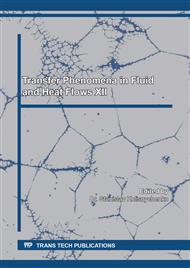[1]
M. Alava, M. Dube, and M. Rost, Imbibition in disordered media, Advances in Physics 53 (2004), 83-175. DOI: doi.org/10.1080/00018730410001687363.
DOI: 10.1080/00018730410001687363
Google Scholar
[2]
J. Cai and B. Yu, A discussion on the effect of tortuosity on the capillary imbibition in porous media, Transport in Porous Media 89 (2011), 251-262.
DOI: 10.1007/s11242-011-9767-0
Google Scholar
[3]
S. Lorimer and T Artymkol, Effect of velocity and diffusion functionality on nonlinear mass transfer mechanisms in solvent oil recovery, Defect and Diffusion Forum 390 (2019), 168-192.
DOI: 10.4028/www.scientific.net/ddf.390.168
Google Scholar
[4]
B. Busahmin and B. B. Maini, Measurements of surface tension for mineral and crude oil systems, Defect and Diffusion Forum 391 (2019), 106-113.
DOI: 10.4028/www.scientific.net/ddf.391.106
Google Scholar
[5]
H. Soleimani et al, Transport modelling of multi-phase fluid flow in porous media for enhanced oil recovery, Defect and Diffusion Forum 400 (2020), 38-44.
DOI: 10.4028/www.scientific.net/ddf.400.38
Google Scholar
[6]
D. Samayoa, L. Álvarez-Romero, L. A. Ochoa-Ontiveros, L. Damián-Adame, E. V. Tobón, and G. Romero-Paredes, Fractal imbibition in Koch's curve-like capillary tubes, Rev. Mex. Fis. 64 (2018), 291-295.
DOI: 10.31349/revmexfis.64.291
Google Scholar
[7]
D. Samayoa, L. A. Ochoa-Ontiveros, L. Damián-Adame, E. Reyes de Luna, L. Álvarez-Romero, and G. Romero-Paredes, Fractal model equation for spontaneous imbibition, Rev. Mex. Dis. 66 (2020), 283-290.
DOI: 10.31349/revmexfis.66.283
Google Scholar
[8]
A. Ya Davletbaev, L. A. Kovaleva, and N. M. Nasyrov, Numerical simulation of injection of a solvent into a production well under electromagnetic action, Fluid Dynamics 43 (2008), 583-589.
DOI: 10.1134/s0015462808040108
Google Scholar
[9]
K. Naderi and T. Babadagli, Influence of intensity and frequency of ultrasonic waves on capillary interaction and oil recovery from different rock types, Ultrasonics Sonochemistry 17 (2010), 500-508.
DOI: 10.1016/j.ultsonch.2009.10.022
Google Scholar
[10]
K. Naderi and T. Babadagli, Pore scale investigation of immiscible displacement process in porous media under high frequency sound waves, J. Fluid Mech. 680 (2011), 336360.
DOI: 10.1017/jfm.2011.166
Google Scholar
[11]
A. Davletbaev, L. Kovaleva, T. Babadagli, and R. Minnigalimov, Mathematical modeling and field application of heavy oil recovery by radiofrequency electromagnetic stimulation. J. Petr. Sci. and Eng. 78 (2011), 646653.
DOI: 10.1016/j.petrol.2011.07.006
Google Scholar
[12]
A.S. Balankin, E.G. Otamendi, D. Samayoa, J. Patino, and M.A. Rodríguez, Depinning and creep-like motion of wetting fronts in weakly vibrated granular media, Phys. Rev. E 85 (2012), 036313.
DOI: 10.1103/physreve.85.036313
Google Scholar
[13]
A.S. Balankin, H. Zapata, E. Pineda, D. Morales, L. Morales, D. Silva, and M.A. Rodríguez, Depinning and dynamics of imbibition fronts in paper under increasing ambient humidity, Phys. Rev. E 87 (2013) 014102.
DOI: 10.1103/physreve.87.014102
Google Scholar
[14]
B. Zhao, A.A. Pahlavan, L. CuetoFelgueroso, and R. Juanes, Forced wetting transition and bubble pinchoff in a capillary tube, Phys. Rev. Lett. 120 (2018), 084501.
DOI: 10.1103/physrevlett.120.084501
Google Scholar
[15]
J. F. Gerónimo, A. HernándezMachado, and E.C. Poiré, Enhanced imbibition from the cooperation between wetting and inertia via pulsatile forcing, Phys. Fluids 31 (2019), 032107.
DOI: 10.1063/1.5086028
Google Scholar
[16]
S. S. Le Guen and A. R. Kovscek, Nonequilibrium effects during spontaneous imbibition, Transport in Porous Media 63 (2006), 127146.
DOI: 10.1007/s11242-005-3327-4
Google Scholar
[17]
I. A. Beresnev and P.A. Johnson, Elasticwave stimulation of oil production – a review of methods and results. Geophysics 59 (6) (1994), 1000–1017.
DOI: 10.1190/1.1443645
Google Scholar
[18]
O. L. Kuznetsov, E. M. Simkin, G. V. Chilingar, Gorfunkel, and J. O. Robertson, Seismic techniques of enhanced oil recovery: experimental and field results. Energy Sources 24(9) (2002), 877–889.
DOI: 10.1080/00908310290086761
Google Scholar
[19]
F. G. Blake, Bjerknes forces in stationary sound fields, J. Acoust. Soc. Am. 21(5) (1949), 551-561.
Google Scholar
[20]
R. Mettin et al., Bjerknes forces between small cavitation bubbles in a strong acoustic field, Phys. Rev. E 56(3) (1997), 2924–2931.
DOI: 10.1103/physreve.56.2924
Google Scholar
[21]
T. G. Leightont, A. J. Waltont, and M. J. Pickworth, Primary Bjerknes forces, Eur. J. Phys 11 (1990) 4750.
Google Scholar
[22]
E. Washburn, The dynamics of capillary flow, Physical Review 17 (1921), 273.
Google Scholar
[23]
N. Fries, M. Dreyer, An analytic solution of capillary rise restrained by gravity, Journal of Colloid and Interface Science 320 (2008) 259263.
DOI: 10.1016/j.jcis.2008.01.009
Google Scholar


